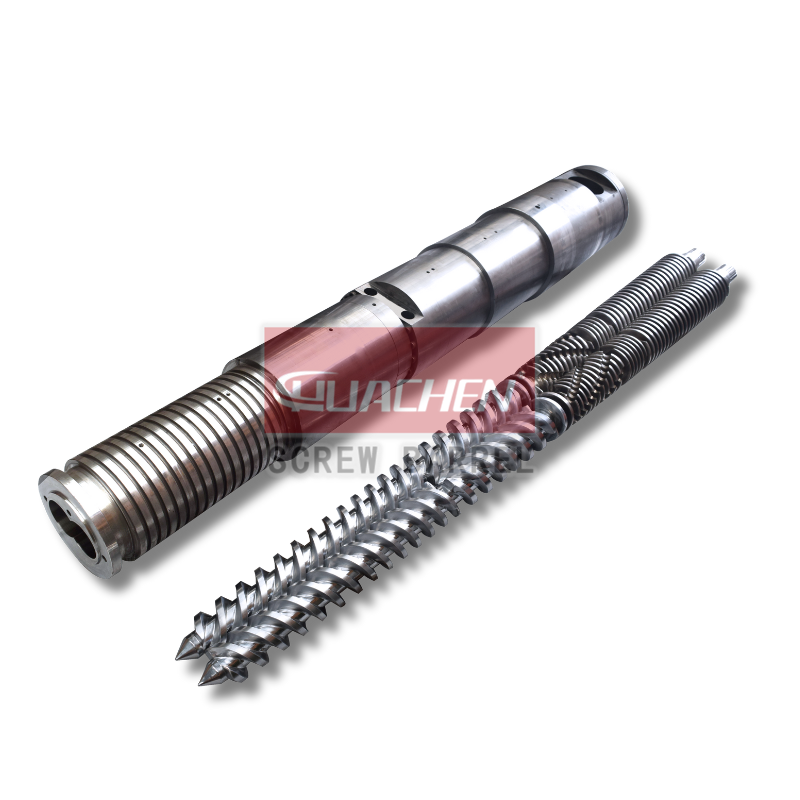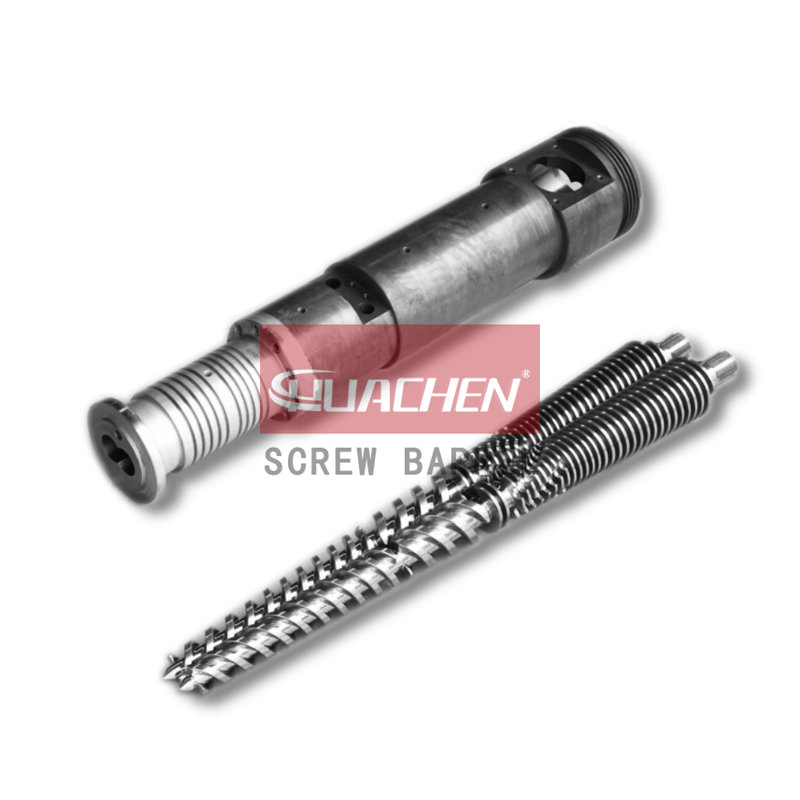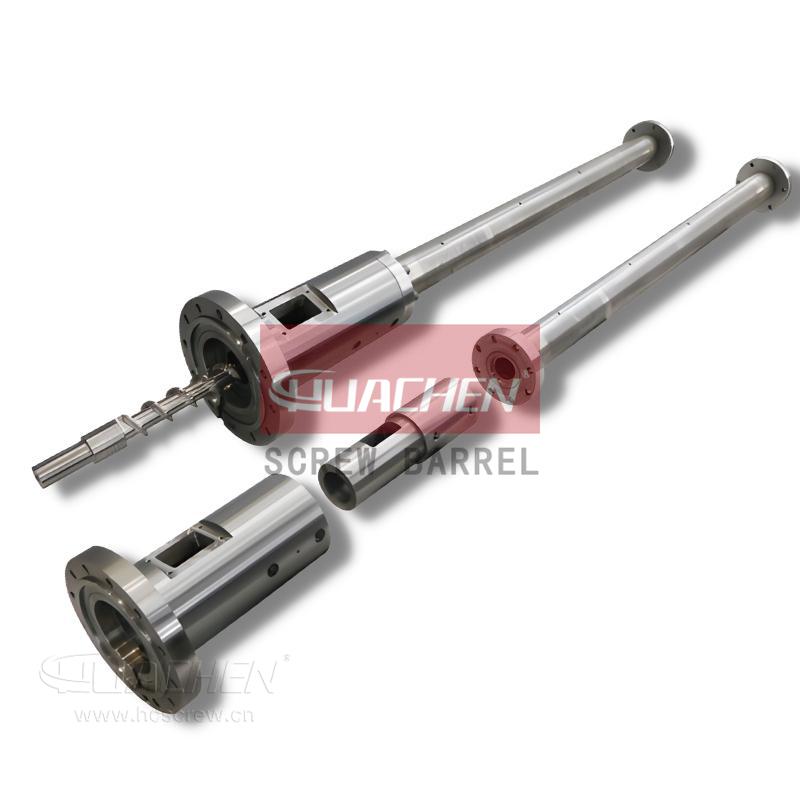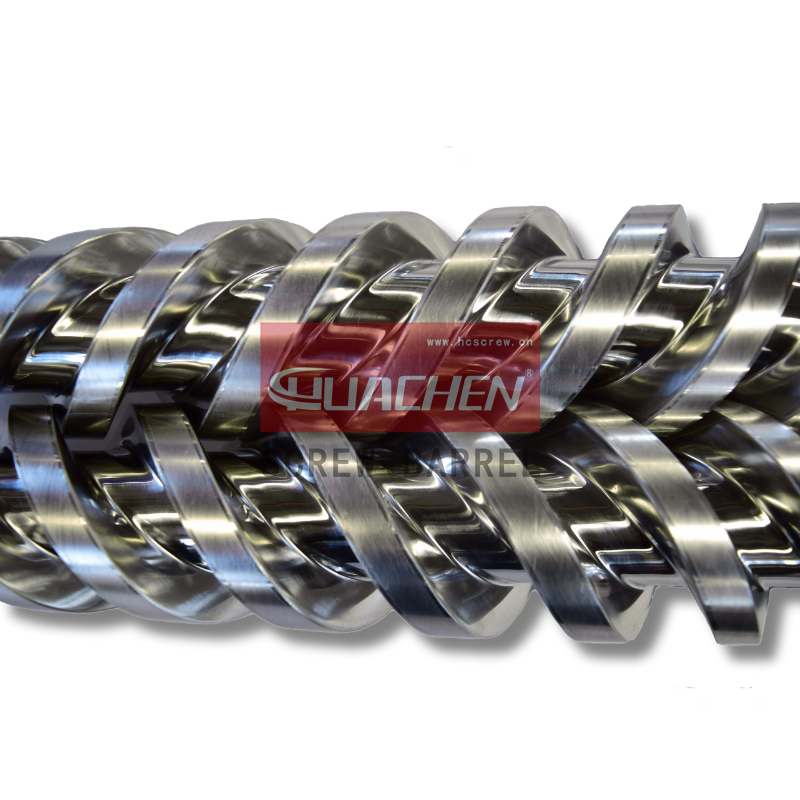Expert Solutions For PVC Profile Extruder Vent Flow Issues with Conical Twin Screw Barrel
Date:2023-3-01 Author:hcscrew
Get expert solutions for PVC profile extruder vent flow issues with our high-quality conical twin screw barrel. HUACHEN screw barrel are designed to optimize extrusion performance and eliminate common issues, such as vent flow problems. Trust our team of experts to provide top-notch solutions for your PVC profile production needs.
Extruder vent flow or polymer flow out usually occurs in the conical twin screw barrel vacuum vent opening. This is a sign of poor plasticisation of UPVC materials, and is also a common and frequent fault among many medium to small PVC profile manufacturers. Although there have been a number of articles and reports discussing the solution to prevent and stop extruder vent flow through the vent opening of conical twin screw extruders, they are not very detailed. In this article, HUACHEN Screw discusses and analyses the causes of extruder vent flow in the extrusion process, product formulation, and screw barrel, and provides effective solutions.
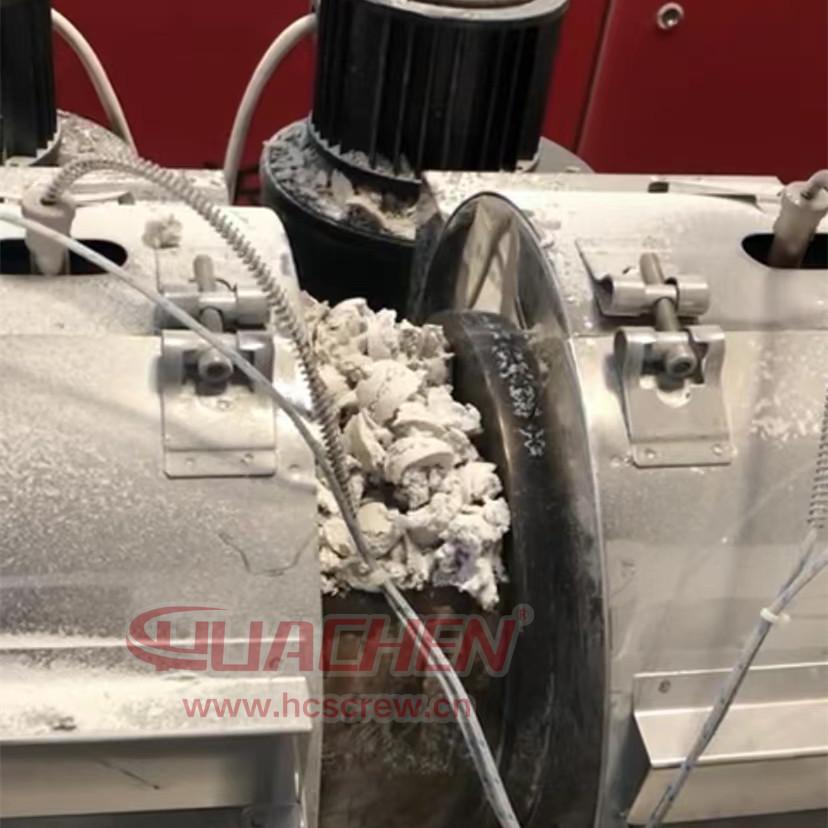
1 Extruder vent flow caused by the extrusion process
(1) The conical twin screw’s feed section has a low external heat power configuration. The set temperature is high again, and the display temperature is still low. As a result of the increased external heat, plasticization of the polymer or compound is not able to be achieved.
(2) The speed of feeding is too fast, the feed section of the screw groove is too full of material, and the shear heat added by the screw is not enough to balance the amount of heat needed to feed the material, resulting in poor plasticisation of the material.
(3) The extrusion speed is too fast, and the increase in shear heat is not enough to balance the material in the feed section and compression section to reduce the residence time and loss of heat, resulting in poor material plasticization.
A conical twin screw barrel with low shear performance is the most likely to experience the above phenomenon. We will use an SJSZ55/110 conical twin screw barrel as an example to explain the point. The screw barrel feed section external heater power is only 3kW. Basically, a conical twin screw structure with four sections: feed section, compression section, melt section, and metering section, that is, a 2-2-1-1 four-section screw structure.
The main reasons for the low extrusion efficiency of this extruder are:
a. The feed section and compression section screw volume ratio is too low.
b. The volume ratio of the feed section to the melt section screw groove is much higher than 1. In addition, the pressure release space of the melt after the compression section is too small, which prepares objective conditions for the vacuum vent opening vent flow out.
c. The shear heat generated by the extruder is seriously excessive.
Due to this, this extruder has a faster feed rate and extrusion speed. Furthermore, the temperature displayed in the feed and compression sections is much lower than the set temperature. The melt section and metering section display much higher temperatures than the set temperature. During screw extraction, the unplasticised material is stripped from the barrel and overflows from the vacuum vent opening. This can result in blockage of the vacuum vent opening, gaps and bubbles in the extruded section, reduced density of the product, and localized overheating and degradation. There is a problem with extruding the product normally.
2 Extruder vent flow caused by formulation
(1) There is too much lubricant in the PVC profile formula, the material moves too fast in the extruder, the residence time is too short, and plasticization is not effective.
(2) CPE impact modifiers result in low processing aids and poor friction performance, which can lead to poor plasticization when the vacuum hole is reached.
For the production of high-quality PVC profiles, lubricants are an essential auxiliary. If the amount added is inappropriate, it can also negatively impact production. In the spiral groove feed section, for instance, if excessive lubricants, such as paraffin wax and stearic acid, are added, the material will not be well plasticised and will appear to flow out of the feed hole. It is worth noting that not only is the lubricant too much, but there will also be polymer flow out of the vacuum vent opening. Too little processing aids combined with the CPE impact modifier formula can result in an imbalance between material lubrication and friction performance. Moreover, the vacuum vent opening will cause vent flow, or even result in the feed section screw not eating. As a result, material flow out may also appear in the feed hole. No matter how the feed speed, feed section temperature, screw and barrel clearance is adjusted, the screw groove is always empty or less than half a groove of material, with ungelatinized powder filling it. It is known as the “slippery wall” phenomenon. It is impossible to form a melt pressure in the screw groove because the feed section is not fed. The only remaining material in the screw groove is not well sheared and plasticized, so the extruded PVC profile has no mechanical properties.
3 Vent flow caused by screw and barrel
A bias in the screw and barrel of the extruder, coupled with vacuum vent leaks, most commonly occurs when the shear performance is high, the working time is too long; also, when the gap between the screw and barrel is too large, resulting in material “counterflow” or “positive flow”.
Here is an example of a 2-2-1-3-3 five-section conical twin screw structure. As the material moves parallel from the double-headed screw groove in the feed section to the single-headed screw groove in the compression section, the pressure rises abruptly. After the compression section single-headed screw groove parallel movement and the melt section three-headed screw groove parallel movement, the pressure plummeted in force. Due to the counteraction of the head, the pressure rises gradually when the material enters the molten section from the three-headed screw groove into the same three-headed screw groove. When the radial clearance between the barrel and the screw increases, the material is on the higher pressure side. The material will flow through the gap to the side with less pressure.
According to the counter-flow principle, the melt pressure is higher in the calculating rubbish section, compressed sections of the material in the screw shear action, and lower melt pressures in the melt section. The feed section reverse flow, flowing to the melt sections, will silt in the vacuum tank due to the overflow from the vacuum hole. As the materials are repeatedly sheared and rubbed in the “counter-flow” process, and as the machine dwells for longer periods of time, the phenomenon of “over plasticization” occurs, and some materials adhere to the barrel wall, causing yellow lines on the profile’s surface. Over time, some of the material degradation will be aggravated, and the yellow line will turn black.
A ‘positive flow’ occurs when the compressed section of the material melts more rapidly in the direction of the molten section of the flow under shear. The material has not been fully sheared, plasticized poorly, part of the material in the vacuum vent opening is not gelatinous, stripped by the barrel, from the overflow, or mixed with the powder was vacuumed away. By decreasing the shearing and friction effect of the screw on the material, “positive flow” leads to “under-plasticization”, leading to brittle profiles. The outer wall and inner tendons were not kneaded well. Using high temperatures will affect the products’ thermal stability and impact performance.
Besides the work of the metering section of the barrel and the screw radial clearance, the extruder also wears a compression section of the barrel and the screw radial clearance. There is often no synchronization between the two types of wear. The Chinese extruder manufacturers have adopted the method of remanufacturing the barrel of the metering section in combination with the original barrel to prolong the barrel’s service life, which solves the issue of the large radial clearance between the barrel and the screw of the metering section. Eliminating the “backflow” problem in extruder production and partial “over plasticisation” of profiles, eliminates the problem of backflow. This eliminates the problem of “backflow” in the extruder and the phenomenon of local “over plasticization” and thermal degradation. In the compression section, however, due to the large radial clearance between the barrel and the screw, not only is the problem not fixed, but the barrel of the metering section has also been renovated. Because of the constraints imposed by the radial clearance between the barrel and the screw, the radial clearance between the barrel and the screw is even larger in the compression section. During production, the “positive flow” in the extruder becomes a source of contradiction, resulting in material “under plasticization”, resulting in an increase in process temperatures.
4 Extruder ent flow caused by the process
Extruder vent flow out must occur in the vacuum vent opening material flow out symptoms of serious analysis in order to be completely resolved. It depends on the process, formula, equipment, and other factors for classification, respectively. The process method cannot resolve vent flow in the vacuum opening of the extruder completely by dealing with the equipment problem, the formula method cannot resolve the process problem, and the equipment method cannot resolve the formula problem.
Although some individual manufacturers still use conical twin screw barrels with low shear performance in China’s PVC profile industry, most of them have been eliminated up to now. As long as the operation process is strict and low temperature or overtemperature or over speed operation is strictly forbidden, the vacuum opening vent flow can also be effectively resolved. However, even with the use of a high-shear extruder. Vent flow problems may also occur if the process parameters are incorrect, the feed speed is too high or too low, the extrusion speed is not compatible with the feed speed, and the barrel setting temperature is too low. In many cases, the material added is insufficient, the compression section shear is insufficient, or the set temperature is too low. In the vacuum vent opening, there is still a trace of powder material, which is pulled away by the vacuum, or the amount of powder is too high, the shear heat or the set temperature is too high, and the material to the vent opening is over-expanded, loosened, stripped by the screw flights, stagnated, piled up, or overflowed.
To reduce excessive barrel wear caused by the extrusion process and the vacuum vent opening vent flow problem, try replacing part of the shear heat with external heat.
Increasing the amount of processing aids and adjusting the variety and amount of lubricants in the formula can solve vent flow issues.
There are five major aspects that contribute to the vent flow caused by the extruder screw and barrel:
① Reduce barrel wear by using optimized technology for operation, such as replacing part of the shear heat with external heat.
② Extruder runs for a certain time (such as 3 or 6 months), and the screw and barrel gap of the extruder must be adjusted based on the formula of calcium carbonate and screw wear. By eliminating the screw and barrel gap caused by excessive material backflow or positive flow, the extruder’s service life can be extended.
③ When the screw and barrel gap is worn out and cannot be adjusted, the screw and barrel should be replaced with a new set. The metering section and compression section should also be refurbished at the same time, rather than just the conical twin screw and barrel.
④ When renewing the screw and barrel, try to use a six-stage screw with a thread head of 2-1-2-1-3-3 or a five-stage screw with 2-2-2-4-3. The 2-1-2-1-3-3 six-stage screw, with step-by-step compression in the compression section, is not only characterised by strong shear performance, but also significantly reduces shear wear on the barrel. 2-2-2-4-3 five-stage screws, with increased heat power outside the feed section and double-headed threads in both the feed and compression sections, reduce shear heat and wear on the barrel. All these types of conical twin screw have positive implications for extending the working life of the extruder and eliminating the vent flow issues.
⑤ If you are purchasing a new screw and barrel, ask the extruder manufacturer to compress the section and metering section of the screw and barrel to improve the toughness and wear resistance of key parts. Contact us now at HUACHEN screw for the latest technical support and quotations.
About the screw barrel Factory: HUACHEN
HUACHEN Screw has been a leading conical twin screw barrel manufacturer in Zhoushan Jintang since 1993. As one of the leading companies in designing and processing twin screw barrels, high speed extruder screw barrel, HUACHEN Screw can provide its customers with a wide range of services, including drawing rebuilding, design, modification, and customized screw barrels. Our company has also successfully exported and supplied screw barrels to customers worldwide.
>>Learn more about our company
You May Also Like
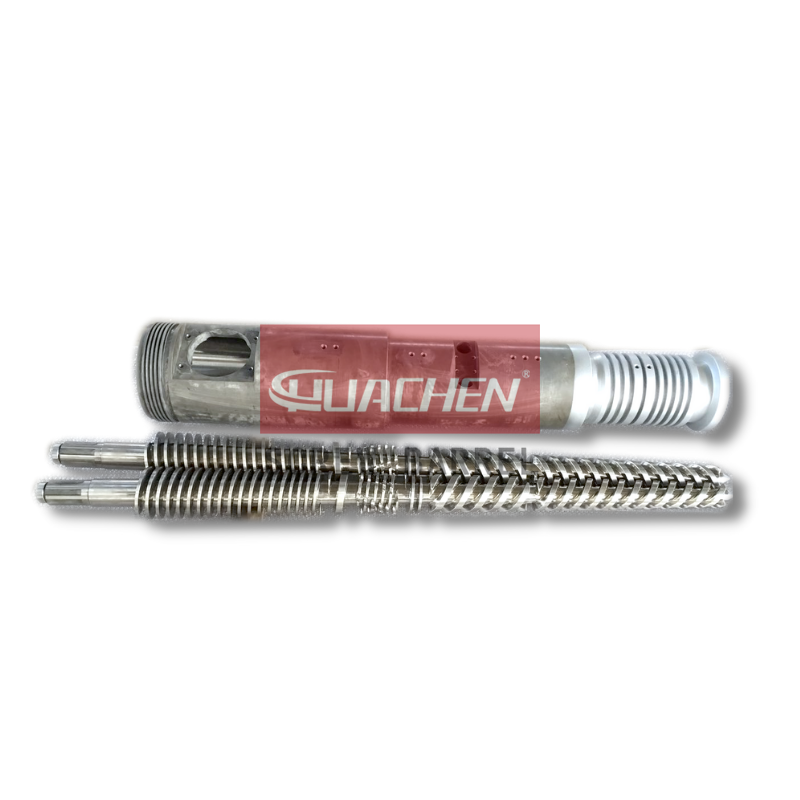 | PVC Profile Extrusion Screw Barrel ↗ Get details and quote for PVC profile extrusion screw barrel. We offer a wide variety of anti-wear screw barrels for many profile extrusions. |
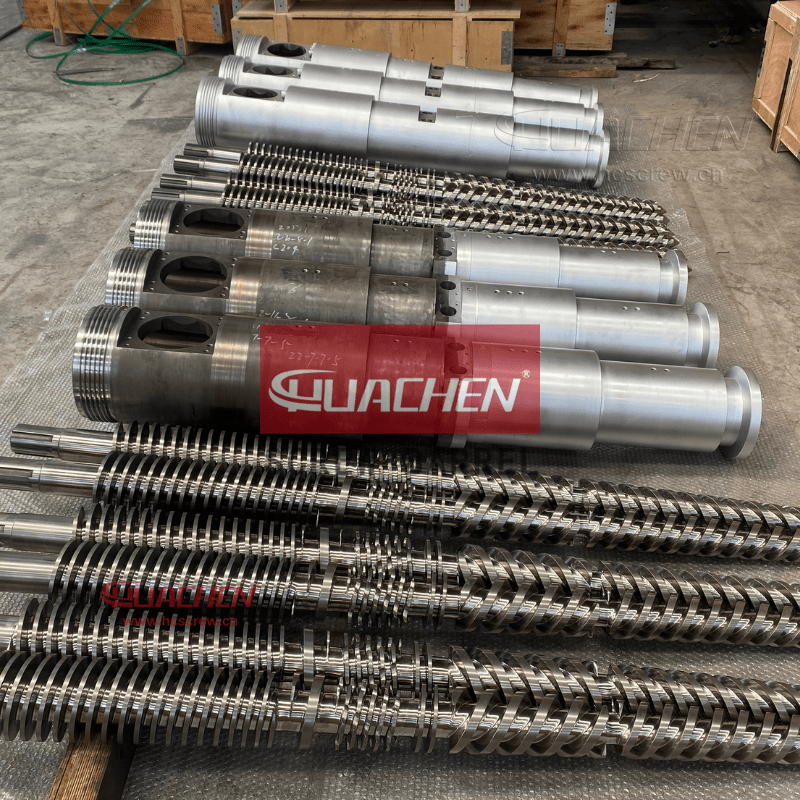 | RPVC, CPVC, UPVC Screw Barrel ↗ Get details and latest price of RPVC, CPVC, UPVC PVC screw barrel, high-speed design, better anti-wear anti-corrosion screw barrel at HUACHEN. |
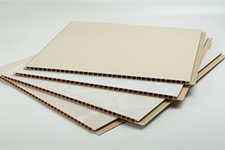 | 25 PVC Pipe And Other PVC Products Making Formulas ↗ Introduce 25 typical PVC product formulas in PVC extruding process. Such as PVC pipe, PVC panel production formula, PVC sheet, PVC profile. |
TAGS
HUACHEN Screw barrel recent post
- High-performance PVC Screw Barrel for Efficient Extrusion
- Durable Conical Twin Screw Barrel for Precision PVC Pipe Production
- High-Speed Screw Barrel for Increased Extrusion Efficiency
- Super Wear-Resistant Bimetallic Alloy Coating Screw Barrel for High Output Extruders
- High-Precision Parallel Twin Screw Barrel for Extrusion Excellence
- Top Quality Single Screw Barrels for Plastic Extrusion Applications
- High-quality Extruder Screw Barrel for Reliable Performance
- Efficient Plastic Extrusion Screw Barrel for Superior Output
conical twin screw barrel extruder screw barrel extrusion screw barrel Foam sheet processing high speed screw barrel HUACHEN SCREW news injection screw barrel parallel twin screw barrel pa screw barrel pe making formula pe screw barrel plastic fiber processing plastic fibre screw barrel Plastic film making screw barrel plastic pipe processing Plastic profile processing Plastic raw material knowledge pp screw barrel PVC making formula pvc screw barrel related parts for screw barrel screw barrel engineering work screw barrel knowledge single screw barrel twin screw barrel
;